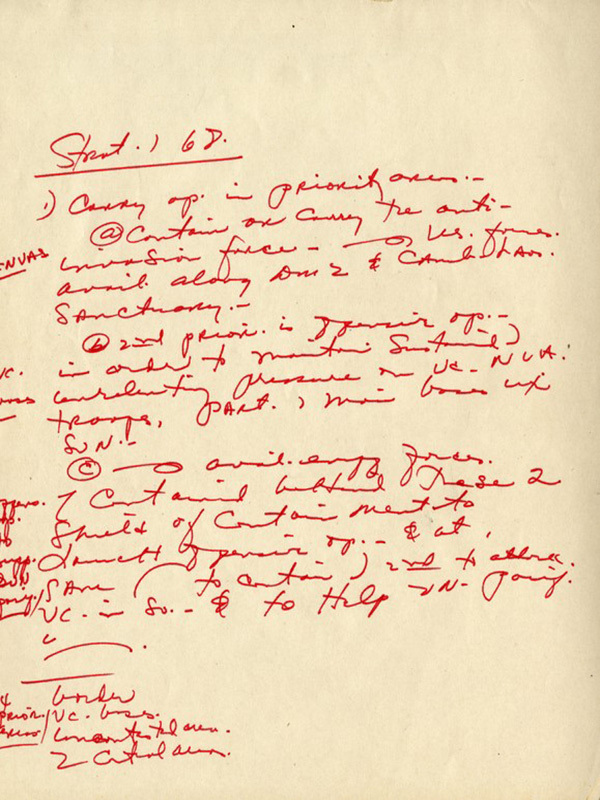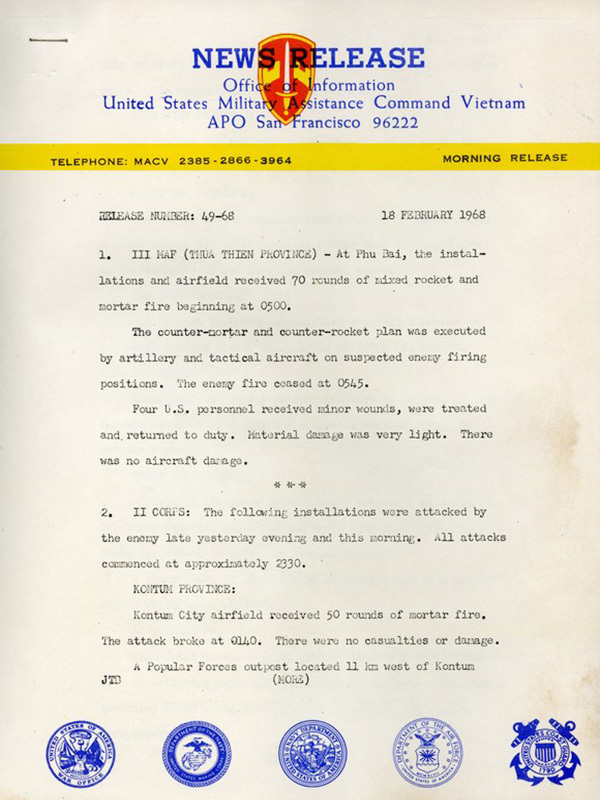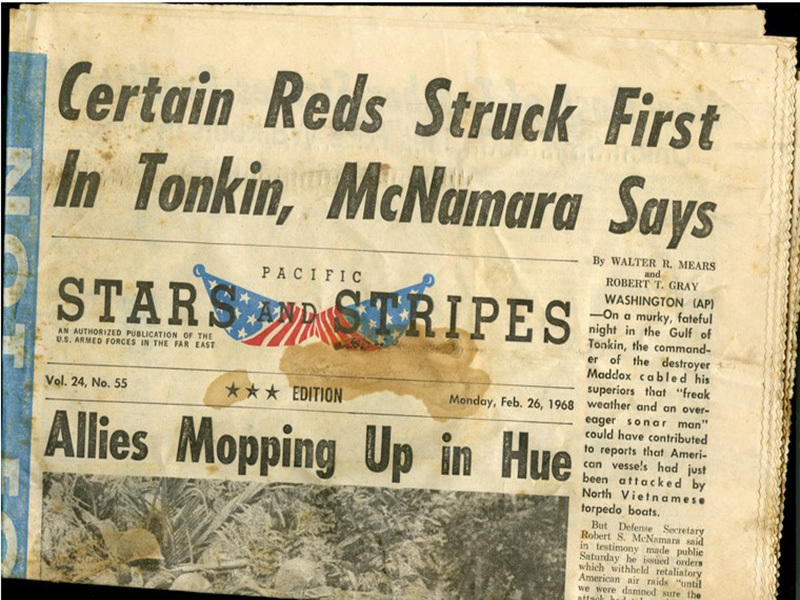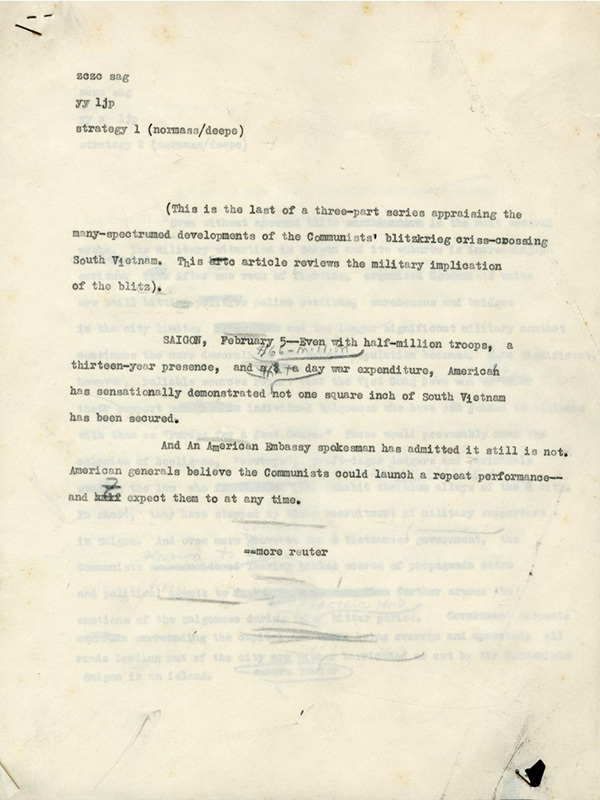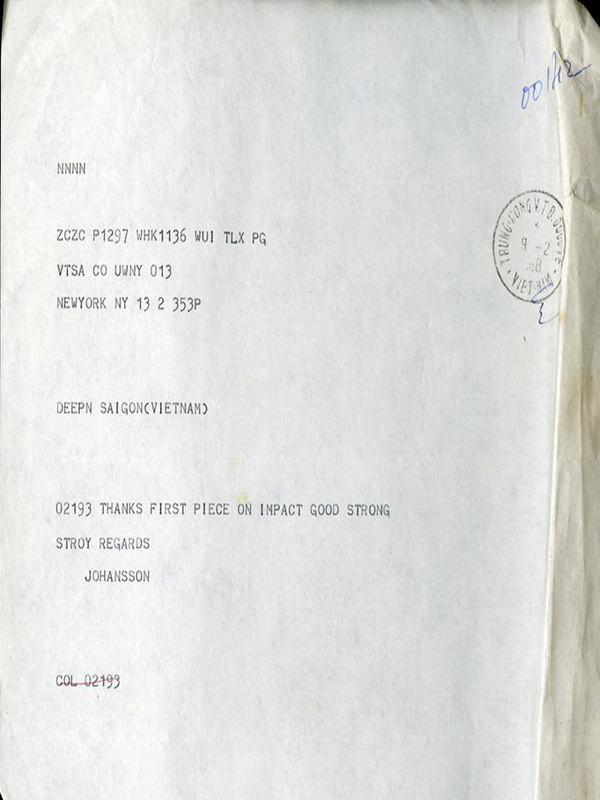The Making of an Article
by Sam Mellema
Beverly Deepe Keever spent 7 years writing, reporting, and photographing the Vietnam War. During that time she wrote for many different publications and adapted to changing communications technologies that made it easier and easier for her to communicate with American newspapers. Within all these changes, Keever had a consistent process for writing her articles, a process that was common among journalists in the 1960’s.
The following sections will walk you through the process that Keever followed for the typical article. As you look through the different notes and files please note that this page does not show the development of a particular article. Rather, we have included examples from many articles Keever was writing around the same time (January and February, 1968) and on the same topic (the Tet Offensive).
Research notes
The first step in writing an article was research. Keever filled small notebooks with interview notes, field observations, statistics, and article ideas. Below is an example of shorthand notes that Keever wrote as she was gathering information for an article. Keever took notes in her own unique style of shorthand (the notes are difficult to parse and even Keever can’t read them anymore). The Beverly Deepe Keever, Journalism Papers in the University of Nebraska-Lincoln Archives has dozens of these small notebooks filled with notes that Keever was almost constantly taking.
Press Releases
Keever added to her research using official press releases. News releases were offered regularly to the press. They would outline major events and military achievements, or communicate what particular military leaders wanted to say. The Army, Navy, Marine Corps, and Air Force sent releases to any member of the press that wanted them. These news releases provided crucial information to journalists and would help paint a big picture of what was going on throughout all Vietnam. However, the press releases were untrustworthy sources that the U.S. military used to push out their own message.
The U.S. military had little control over press coverage of the war. This was partially a political tactic, since the U.S. government wanted to appear as if they were not censoring the press. It was also a function of the kind of war that was being waged in Vietnam. Since Congress never officially declared war, the military could not apply wartime rules to the reporters. Instead of using censorship, the military tried to control the war’s narrative by pushing out the information that they wanted journalists to publish.
Press releases emphasized American victories and communist losses, while giving as little information as possible. This U.S. tactic toward the press is best summed up by George McBundy, Kennedy’s national security advisor, who once wrote on a communique (i.e. a press release) that “a communique should say nothing, in such a way as to fool the press without deceiving them.”
The press briefings that that were most notorious for these tactics were the Joint United States Public Affairs Office (JUSPAO) daily press briefings. Most journalists quickly learned that these briefings were mostly lies or contained very little information at all. Because of their uselessness, journalists began to call the press briefings the “Five O’Clock Follies,” and very few press attended.
Reading Other Newspapers
A big part about being a journalist in the Vietnam War was reading other people’s writings and stories to get a better sense of what was going on in Vietnam. Newspapers could tell a journalist about events in other regions of Vietnam or about press conferences they didn’t attend. Newspapers from other countries also often covered how their own governments and civilians were responding to the war. Keever often used the Vietnamese newspapers to gauge the Vietnamese civilian reactions to the war and to American troops.
Other newspapers could also tell a journalist what articles other countries were interested in. Newspaper journalists from all over the world came to cover the war, but their publishers and reading public were often interested in different subjects. Keever usually wrote for American newspapers, but she occasionally wrote for Australian and British newspapers, which were more willing to publish articles that were critical of the war.
Here is an example of one of the many newspapers from Vietnam that Keever collected over the years. This is an issue of Stars and Stripes, a military newspaper designed for military personnel. Keever paid special attention to civilian American, official military, and Vietnamese reporting.
Writing Article Drafts
Once Keever had collected all her notes, releases, interviews, and other newspapers’ coverage, it was time to write an article. Here is an example of the first page of her rough drafts. After slight editing and finalization, Keever would send these articles back to the US via cable or leased wire service.
Many of Keever’s early articles are in “cablese,” i.e. the unique language that was used to send cables. For example, one letter words like “I” are replaced with longer versions like “aye,” sentences end with “stop,” and codes are used for the cable’s intended recipient. Later in her time in Vietnam, as Vietnam got more Western reporters and there was more infrastructure to support them, cablese was no longer necessary and articles were sent via wire service.
Telegrams from Editors
After receiving the article by cable, the main office would often send back a confirmation telegram thanking Keever for the article. Sometimes they would give her information on if or when the article will be published. Sometimes they would ask for more edits or even reject the article. Here is an example of a telegram from Boston signed “Johansson.” The cable came from the main office of The Christian Science Monitor.
Publication
Once the publisher was happy with Keever’s articles they would prepare to print it. Keever never had control of the headline, what the article would look like, or what images would be used with it. These were her publishers’ decisions to make. Here are two copies of the front page of The Christian Science Monitor, one of the news outlets Keever worked for while in Vietnam. Keever’s articles make appearances on both of these front pages. From here, the newspapers would be distributed, and Keever’s articles would be read all around the country and around the world.


